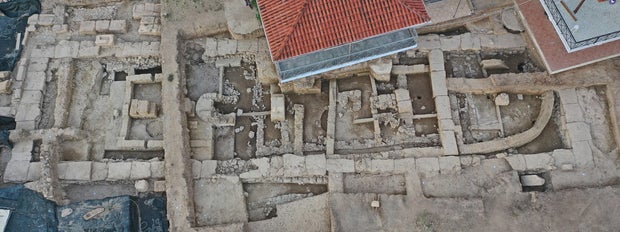Archaeologists excavating a sanctuary honoring the ancient Greek goddess Artemis have announced they discovered a significant number of structures, as well as plentiful relics, including gold and silver jewels.
A “monumental building in the heart of the sanctuary” was first found in 2017, according to a recent social media post from Greece’s Ministry of Culture. Another temple was found in 2023. Excavating this second temple turned up “rich relics” and jewelry, the ministry said. Other excavations found buildings from the ninth and eighth centuries B.C.
The excavations are conducted annually by a group of Swiss and Greek archaeologists, the Ministry of Culture said in a news release. The research project began about 15 years ago, the ministry said.
Greek Ministry of Culture
The temple found in the 2023 excavations dated back to the seventh century B.C. The temple was nearly 100 feet long, a size seen in other temples built during this time period. Inside the temple were multiple constructions, including hearths used as altars and a horsehoe-shaped altar that was covered in ash that proved to be rich in charred bones. Some of the altars may predate the temple, the ministry said, noting that the horseshoe-shaped altar had pottery dated as far back as the eighth century B.C.
Inside the temple, archaeologists found vases, jewelry made of gold, silver, coral and amber, amulets brought from Asia and other parts of the East, and bronze and iron fittings.
Below the temple, archaeologists found dry stone walls that belonged to a building built similarly to the temple itself. Here, researchers found bronze figurines from the Geometric period, which ran from 900 to 700 B.C., and a clay bull head from the Mycenaean period, which lasted from 1,750 to 1,050 B.C.
Gilles Weber
The temple was partially destroyed in the sixth century B.C., likely by a fire, the ministry said. Another temple was built in the area towards the end of that century.
The research into the sanctuary and the temples within it is being conducted in parallel with a survey of the surrounding area. The research “aims to understand the inclusion of the sanctuary in the ancient landscape” by studying the area, its rural settlements and agricultural land, and the communication and connections between ancient cities, officials said.
Earlier this week, Greek archaeologists announced they had uncovered an ancient aqueduct built by a Roman emperor along with more than two dozen silver coins.




